Flexo Printing | Mid-Web Press Answers Shift to More SKUs, Short Runs
- Published: July 16, 2015, By Wallace Nard, KYMC America
A newly introduced MidCentral (mid-web) flexo CI press responds with an ideal solution for SKU proliferation while reducing capital investment for faster profitability in short runs.
By the end of 2015, the baby boomer generation will be 76 million members strong, with male boomers’ life expectancy at 75 years old, and female boomers living to nearly 80 years old. This aging demographic is projected to control 53% of the ~$700 billion spent on groceries. On the other end of the age spectrum is the on-the-go Millennial generation. Both demographics have contributed to the rise in the number of single-person households, which has created the need for smaller portion-packs and ready-to-eat foods. Of course, there are the existing consumers that are looking for products in convenience packaging as well.
For the packaging industry, this enhances how packaging is developed, marketed, and distributed. Brand owners have noted the changes in consumer purchasing and have shifted both how and where CPGs produce their products. Because of these changes, the total output of packaging produced has increased; however, the total number of orders, as well as the distribution of those orders, is different. The number and frequency of long-run orders has decreased dramatically, while the number and frequency of runs has increased, especially for:
- Private labels
- Innovative products
- Special event graphics and marketing on packaging
- Seasonal products
- Low-volume SKUs
- End-of-life products
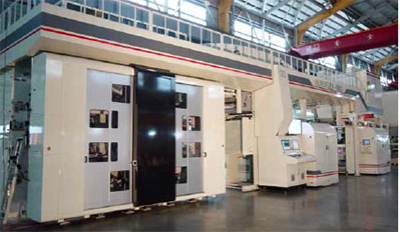
The traditional packaging supply chain challenge has been able to manage volume. The most pressing challenge for converters today is not only to manage volume, but to manage shorter runs. Companies with an infrastructure tailored for volume typically have a difficult time handling shorter runs with flexibility and lower costs. This problem creates opportunities for companies that can more effectively manage the shorter runs, as well as produce high volume orders profitably. Some companies are working to reengineer their businesses to better manage volume and frequency, and new machinery could help with that.
Not only have short runs proliferated the packaging space as of late. There also appears to be a shift toward moving manufacturing supplies closer to demand locations, sometimes even regionally. The ability to meet their customers’ demands for unique packages, rapid delivery, and response times, as well as maintaining low inventories, has propelled this return of manufacturing to the US. In a study conducted by consulting firm Accenture, 61% of respondents said they were considering more closely matching supply location with demand location by, on, or near shoring manufacturing and supply.

As offshoring of manufacturing and packaging shifts back to local supply chains, the cost for retooling locally while considering ROI becomes a major challenge. Continuing structural changes in the packaging industry with consolidation among converters, and increased material costs, has significantly added pressure on prices and margins. The cost of capital equipment and financing is an important consideration, coupled with shorter runs in today’s environment.
Flexo Presses Attempt to Respond to the Demands
Over the years, a number of flexo press manufacturers have entered the market with a mid-web central impression (CI) press, but these attempts failed to penetrate the market. The approach was a low cost, lower speed press, based on the theory that speed should not be an issue for short runs.
This concept did not remain viable for the constantly changing market, however. High-speed flexo has become a trend but has had its challenges. Ink containment, slinging, and ink misting, together with proper fill and ink release from anilox cells at higher speeds, require special converter expertise. The wider and faster you go, the more plate and anilox sleeve accuracy becomes a problem, leading to critical print pressures and even bounce problems throughout all speeds.

Then there is the approach of a robotic press change that can pre-store multiple jobs in a holding rack, on-the-ready for the next job change. This high-speed press concept has met limited market acceptance, mainly with larger converters for longer runs that are decreasing each year. The high cost of this approach has also been a drawback for most converters.
Next came the approach of going wider with a combination of SKUs across a web, but this was never met with widespread acceptance from a practical point of view, due to the scheduling problems it can pose. With so many innovative mid-web presses that have come onto the market, none have truly addressed the short-run, sku proliferation problem that the packaging industry is currently facing.
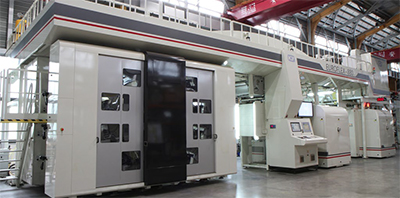
Mid-Web Flexo Machinery as a Solution
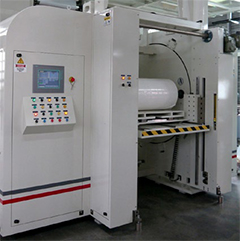 Mid-web flexo can be defined several ways, but we will define it as 27 in. (670 mm.), 34 in. (870 mm.) or 42 in. (1,070 mm.) web widths. A mid-web press can contribute greatly to reduced print impression pressures.
Mid-web flexo can be defined several ways, but we will define it as 27 in. (670 mm.), 34 in. (870 mm.) or 42 in. (1,070 mm.) web widths. A mid-web press can contribute greatly to reduced print impression pressures.
How does the total indicated run out (TIR) and printing pressure relate to a mid-web press? If you have a printed area that is 42 in. wide and a print repeat of 28 in., this equals 1,176 sq. in. of printed area. A 62 in. wide press with the same 28 in. repeat equals 1,736 sq. in. It is logical that with a print area 32% larger there will be a greater TIR of the mounted plate on the sleeve to deal with and greater anilox TIR as well.
 Lower impression settings between the anilox and plate contributes to sharper print, there exists a better opportunity to control the defined lower impression between the anilox and plate to transfer the ink only to the surface of the plate and not into the sides and relief areas of the plate.
Lower impression settings between the anilox and plate contributes to sharper print, there exists a better opportunity to control the defined lower impression between the anilox and plate to transfer the ink only to the surface of the plate and not into the sides and relief areas of the plate.
After conducting extensive engineering and print trials, a press that can answer the need for a midweb press is now on the market: A 34-in. (860 mm.) 8- and 10-color all servo CI press. This machine has been engineered to meet the challenges of shorter runs and at the same time be able to run at high speeds to handle longer runs profitably. It is able to achieve gravure print quality with higher screens—175 lpm—that can be achieved easily with the flexo process, while running multiple SKUs using extended gamut and HD flexo, at a lower cost.
The new mid-web flexo press has been smartly built. Anilox sleeves hold closer tolerances. Even though they are larger in diameter, this press’s anilox sleeves hold closer tolerances. Because of width, the machine offers closer and tighter tolerances of the plate and bridge sleeves.
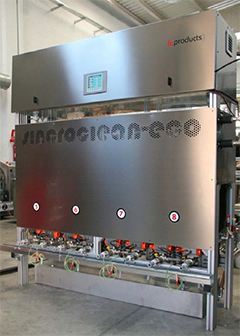 Production costs were considered, with less ink waste from run to run through better ink management; less expensive flexo plate costs; reduced plate mounting time and materials; and an overall lower energy consumption.
Production costs were considered, with less ink waste from run to run through better ink management; less expensive flexo plate costs; reduced plate mounting time and materials; and an overall lower energy consumption.
Changing plate and anilox sleeves is easier on this machine because of weight and size. Setup times for printing pressure adjustment and register accuracy is achieved faster because the mid web is more operator-friendly.
Ink Flow Advancements to SKU Proliferation
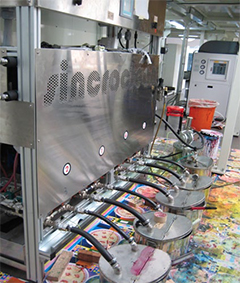 Ink usage was closely considered when designing this flexo press. Present on this machine is Sincroclean Constant Ink Flow Technology (CIFT), with individual ink flow control at each color station. Ink flow settings can be stored for repeat runs, thus eliminating the time it takes to input this information each time. There are three settings for light, medium, and heavy cleaning. Enclosed chamber doctor blade leakage is reduced through controlled chamber ink and cleaning pressure. Spare enclosed chamber doctor blades are lighter and easier to handle for offline changing of blades and end seals.
Ink usage was closely considered when designing this flexo press. Present on this machine is Sincroclean Constant Ink Flow Technology (CIFT), with individual ink flow control at each color station. Ink flow settings can be stored for repeat runs, thus eliminating the time it takes to input this information each time. There are three settings for light, medium, and heavy cleaning. Enclosed chamber doctor blade leakage is reduced through controlled chamber ink and cleaning pressure. Spare enclosed chamber doctor blades are lighter and easier to handle for offline changing of blades and end seals.
Down-gauging to thinner materials is easier and better handled, and overall material waste during set up is lower, all due to the width of the substrate.
Also, a defect detection unit is used. If run at more than 2,000 fpm, it requires shorter measuring times. The mid-web press, running at reasonable speeds in the 1,200 to 1,400 fpm range, can handle 100% defect inspection easier.
With the advent of HD flexo, expanding the use of extended gamut or G7 implementation in combination with Gray Component Replacement (GCR), the mid-web concept takes on an entirely new appeal for shorter runs. A mid-web press makes it easier to set and control the impression, making it easier to consistently hit set target points on press.
By combining higher printing speeds with the ability to better maintain control of the print process, it is possible to meet the demands of the changing needs of the packaging supply chain.
About the Author
Wallace Nard is president/owner of KYMC America, Carol Stream, IL. His career in the printing and converting industry spans more than 55 years. He started his career in flexo in 1957 working for Porter and Dugas, becoming general manager in 1964. He then became VP of Reilly Lake Shore Graphics in the 1970s. He joined Anderson & Vreeland in 1973, working his way up to marketing manager. In 1989, Nard formed Novaflex, a printing and laminating sales/service group.
He was elected to the FTA Board of Directors in 1979 and again in 1982; he also served as chairman of the board of FFTA. He was chairman of the FTA Annual Forum in 1983 and has spoken at numerous gravure and flexo association meetings. He was an editor for Flexography: Principles & Practices and the holder of several patents related to the graphics industry. Nard was inducted into the FTA Hall of Fame in 1988 for his lifetime contribution to the industry.












